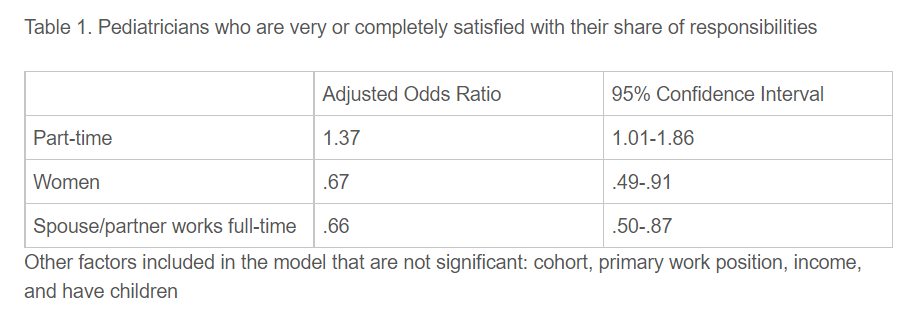Amy J Starmer, MD, MPH, FAAP; Mary Pat Frintner, MSPH; Kenneth Matos, PhD; Chloe Somberg, BA, Bobbi J Byrne, MD, FAAP.
Presented at the 2017 Pediatric Academic Societies Annual Meeting.
Background: Physician careers involve multiple professional commitments that must also be balanced with responsibilities at home. Data describing factors associated with work-life balance for physicians are limited.
Objective: To examine: 1) experiences of pediatricians with household responsibilities and work-life balance; 2) divisions of household work by gender, and; 3) factors and themes associated with work-life balance and satisfaction with responsibilities.
Methods: National data collected in 2015 from the AAP Pediatrician Life and Career Experience Study (PLACES), a longitudinal study of early career pediatricians with 2 cohorts: 1) 4-6 years post-residency and 2) 11-13 years post-residency. Chi-square tests compared experiences by gender. Multivariable logistic regression examined the independent effects of gender on a) primary responsibility for household work and b) satisfaction with share of household responsibilities, while controlling for other characteristics. Comments from 2 open-ended questions on work-life balance challenges and strategies were formally reviewed for common themes.
Results: 74% of PLACES participants completed the survey (1328/1803). Women were more likely than men to identify as having primary responsibility for 13 of 16 household responsibilities, such as cleaning, cooking, and routine care of children (all p<.001, Figures 1 and 2). Men were more likely to identify as having primary responsibility for outdoor work, household/car repairs, and budget management (all p<.001). All of these gender differences except budget management remained significant when controlling for cohort, part-time work status, and spouse/partner work status, p<.01. Women were less likely to be satisfied with their share of responsibilities relative to others in the home (54% vs 64%, p<.01), which remained significant in multivariable analysis (aOR=.67, 95% CI=.49-.91, Table 1). Open-ended comments (n=1137) revealed many barriers to achieving work-life balance. Strategies to increase work-life balance included reducing work hours, outsourcing household work, and utilizing online family calendars.
Conclusion: Pediatricians who are women spend more time on household responsibilities than men and gender is a key factor associated with work-life balance satisfaction. These discrepancies are especially important in medicine where struggles with work-life balance and burnout are common and percentages of women entering medicine have increased.

Last Updated
10/18/2021
Source
American Academy of Pediatrics